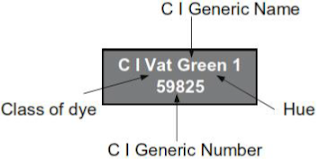Nomenclature of a coloring material is of paramount importance and very interesting, a successful dyer must have some knowledge of it, which can also be obtained from manufacturer’s literature. There is no symmetric nomenclature system worldwide due to which it is usual to have various names assigned to a single dye by different manufacturers, called commercial names. To avoid confusion in it, SDC (Society of Dyers and Colorists) and AATCC (American Association of Textile Chemist and Colorist) have assigned Color Index (CI) specification in terms of “colour index generic name” and “color index generic number” to a dye, which may have different commercial names but chemical structure and properties are identical.
For example, an acid red dye may have the name, C I Acid Red 1 etc followed by its C I generic number as CI 18050 (a five digit number). The C I specification assigned to a dye has been explained in the following figure.
 |
| Description of C I specification of colouring materials (Source: Colour Index) |
Interpretation of commercial name of dye
Name of a commercial dye consists of three parts – brand name, hue and its specification.
- The name starts with a brand name assigned by a specific manufacturer, e.g., disperse dyes produced by Indian Dyestuff Industries (IDI) is assigned a brand name “Navilene”, while that produced by ICI is “Dispersol” etc; naphthols by Amar dye industries is “Amarthol” while that by Atul is “Tulathol” etc.
- The second part describes the hue, e.g., red, green, blue, yellow etc while the third part describes its specifications, e.g., Y for yellowish, G for greenish, R for reddish, B for bluish etc; this last part generally contain some more characters, e.g., 2G, 3G etc, i.e. double greenish, triple greenish, just to express intensity of greenish tone and so on.
- Sometimes a letter in the third part indicates the dye class, e.g., Alizarin Blue D (D for direct dye); Alizarine light blue SE is an acid dye (S for sauer, i.e., acid) etc. Introduction of an “F” in the third part indicates its good light fastness property (Finar, 1975).
- Finally, to complete the description, let the name of a reactive dye be “Procion Red M5B” which implies that, it is from ICI (ICI assigns its reactive dyes trade code “procion”), hue is red and M for cold brand reactive dye with 5B indicating that the red hue is with an intense blue tone.
Texpedi.com
Check out these related articles:








